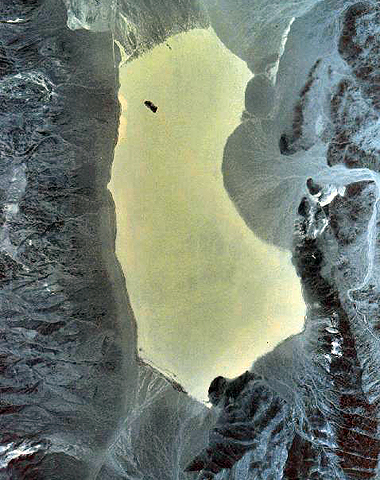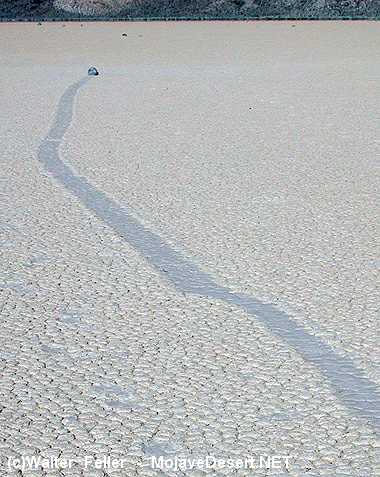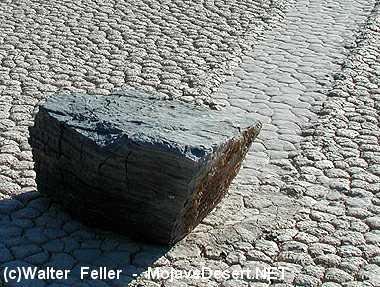--
Geology > Death Valley Geology
Racetrack Playa
The Mysterious Sliding Rocks of Racetrack Playa
The level surface of this parched basin provides the backdrop for one of Death Valley's most intriguing geological
puzzles, the mysterious sliding rocks of Racetrack Playa. Scattered across the extraordinarily flat surface of
Racetrack Playa, far from the edges of the surrounding mountains are boulders, some up to 320 kg (705 lb), and
smaller pieces of rock. Stretching behind many of the stones you'll see grooved trails. Some are short, some long,
some straight, some curvy. Clearly, these rocks must gouge furrows as they slide across the playa surface, yet
no living person has ever witnessed these amazing rocks move!
What makes these rocks skid as much as 880 meters (2890 ft.) across the flat playa surface? Recent scientific
sleuthing provides some answers.
The Playa Surface
Racetrack Playa is an almost perfectly flat dry lake bed nestled between the Cottonwood Mountains to the
east and the Last Chance Range to the west. During periods of heavy rain, water washes down from nearby mountain
slopes onto the playa, forming a shallow, short-lived lake. Under the hot Death Valley sun, the thin veneer of
water quickly evaporates, leaving behind a layer of soft mud. As the mud dries, it shrinks and cracks into a
mosaic of interlocking polygons.
What the Trails Tell
The shallow furrows and rounded, levee-like ridges that form the "trails" of the sliding rocks are clues
that suggest the stones move only when the playa surface is soft and wet. Anyone who has ever slipped in a
mud puddle knows that water-drenched mud makes an incredibly slick, low-friction surface. Once an object is
put into motion on a very low-friction surface, it may move quite a distance before it stops.
Some researchers thought that gravity was the culprit and that the rocks might be sliding downhill on a very,
very shallow slope. However, this hypothesis was discarded when it was shown that the northern end of the
playa is several centimeters higher than the southern end, so many rocks actually move uphill!
Without any witnesses to the sliding rock phenomenon, it's been difficult to prove exactly what makes Racetrack
rocks move. Researchers have also been hampered because traces left behind by sliding rocks are short-lived. Small
rock trails may be washed away by a single rain storm. Even trails gouged into the playa by the largest boulders
last no more than seven years.
A High-tech Solution
Researchers noticed that although some trails change direction, most trend in a generally southwest to northeast
direction. This is consistent with the direction of the prevailing winds. Could wind really provide the force that
sets the largest Racetrack Playa boulders in motion?
One recent study used a high-tech approach in an attempt to solve the mystery of the sliding rocks. Detailed
measurements using Global Positioning System (GPS) instruments were made of over 160 sliding rocks and their trails.
After analyzing their rock trail map, researchers found that the longest, straightest trails are concentrated in
the southeastern part of Racetrack Playa. In this area, wind is channelled through a low point in the mountains,
forming a natural wind tunnel. In the central part of the playa two natural wind tunnels focus their energy from
different directions. It's in this area that rock trails are the most convoluted.
So the evidence suggests that strong gusts of wind and swirling dust devils, in combination with a slick playa
surface may set even the heaviest the rocks in motion. Off they go, scooting along downwind until friction slows
them down and they come to rest. There the stones wait for the next time when slippery mud and wind spur them
into action again.
Also see:
Landforms & Erosional Processes
A playa is a dry, vegetation-free, flat area at the lowest part of an undrained desert basin...
Death Valley National Park
The lakes dissappeared approximately 10,000 years ago when ...
Natural Formations
In desert basins, where rivers merge but do not drain...
Racetrack Playa
Racetrack Geology Tour
Rocks of Racetrack Playa

Satellite image of Racetrack Playa. The Last Chance range is on the left, Cottonwood mountains to the right of the light-colored playa surface.

A sliding rock and its trail cut across Racetrack Playa.

Note the shallow furrow and rounded, levee-like ridges that form the "trail."